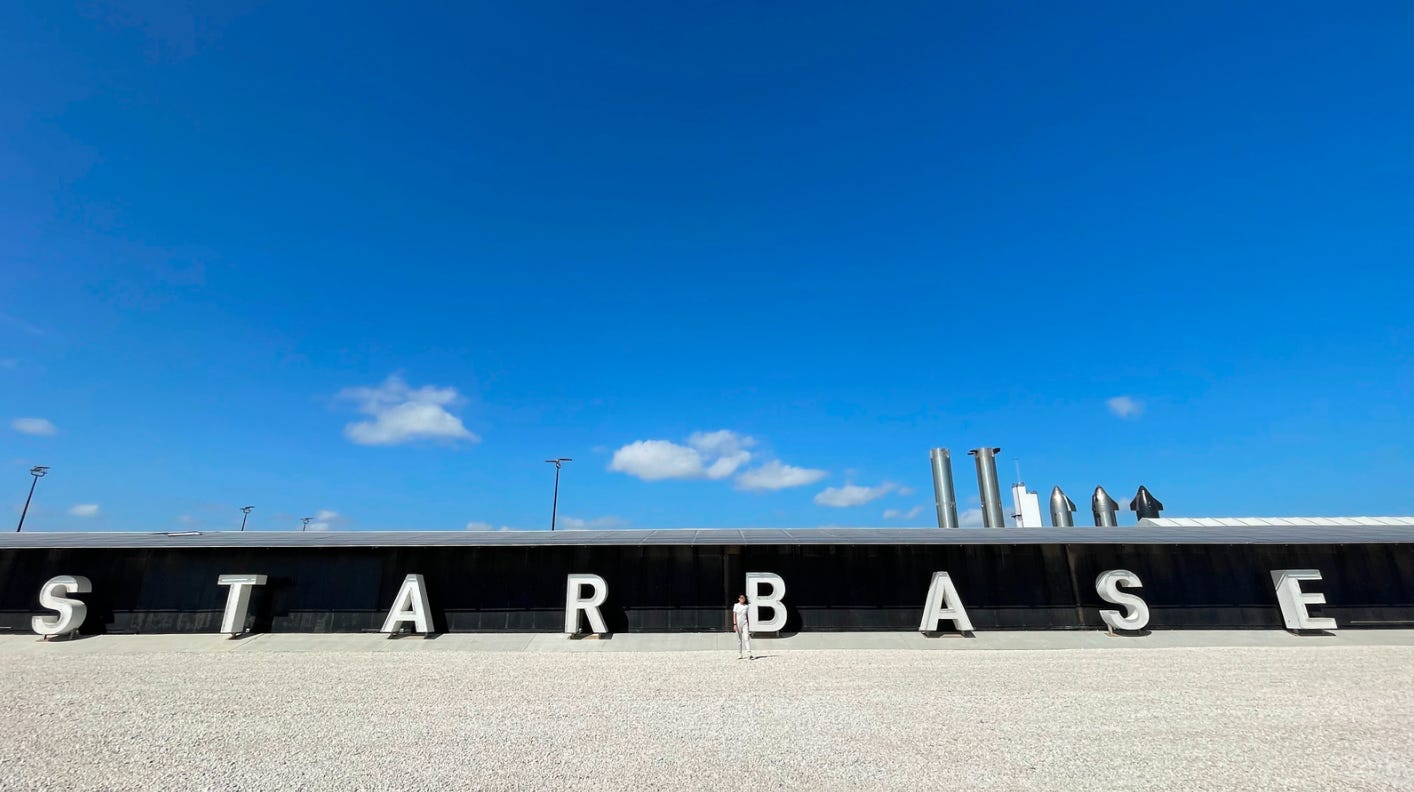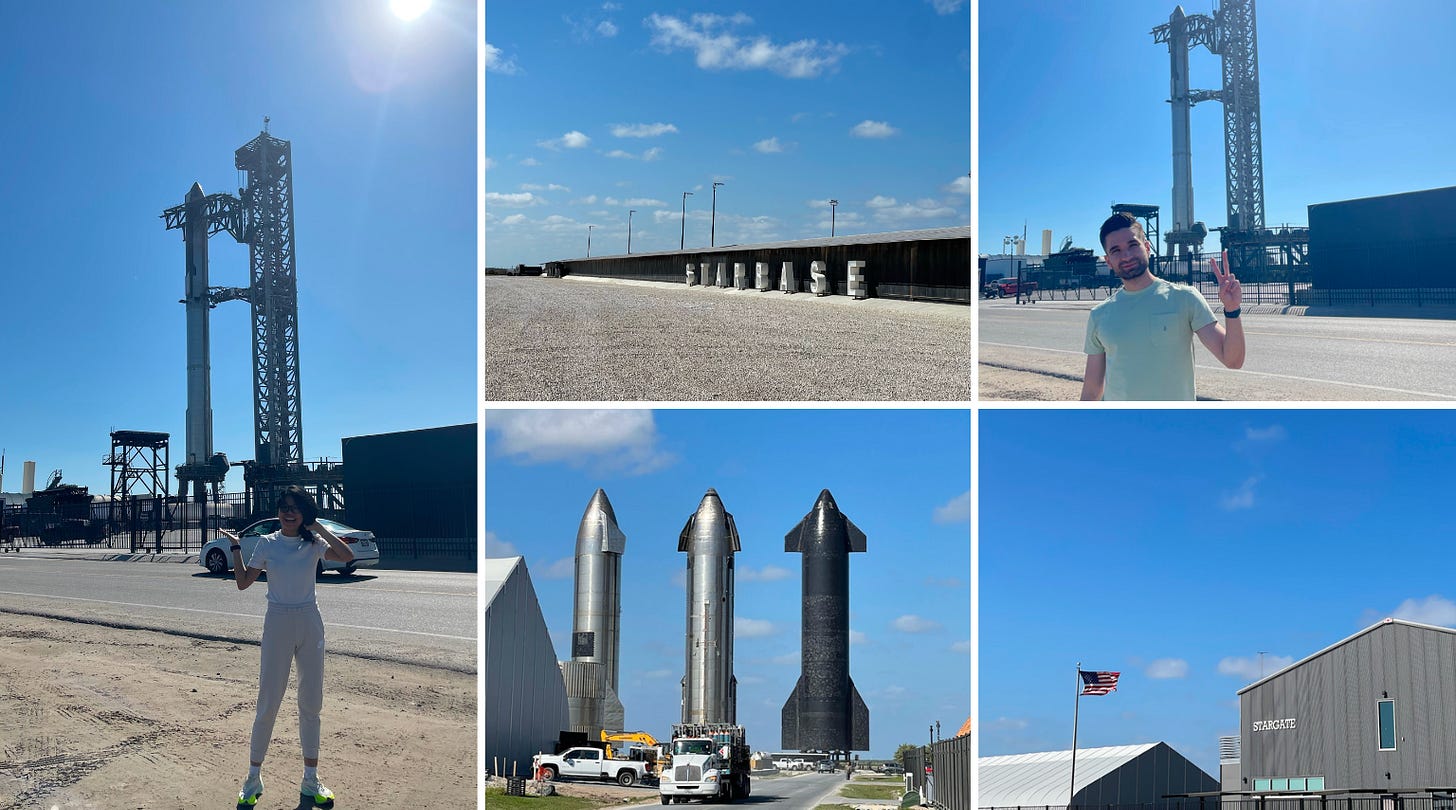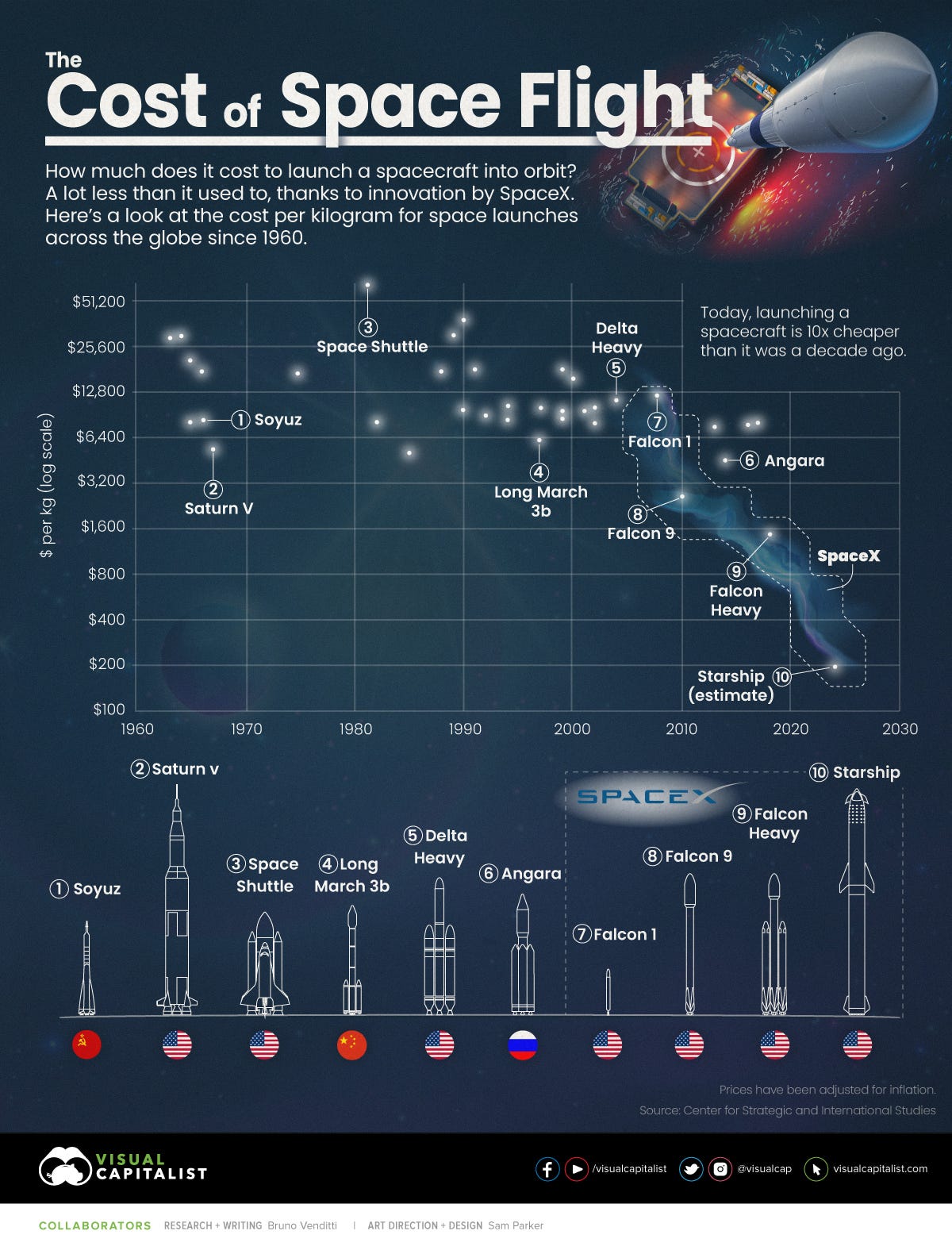Newsletter 103: Exploring the Next Frontier: A First-Hand Look at the Future of Space Technology
If I were to ask you to point to the most remarkable and technologically advanced place on Earth, where would you direct me?
Is there a location that defies the realms of imagination and feels like a glimpse into the future?
A spot where we can temporarily set aside our daily struggles and take comfort in the knowledge that human innovation has the power to overcome even the most daunting challenges.
I am curious about what you would say, but let me share my answer with you.
The First Step to a New Frontier: Departing Singapore for the USA
A month ago, my girlfriend and I embarked on a trip that’s been on my mind for a long time — the United States.
Visiting the US has been a dream of mine for many years, but the timing never seemed quite right. As a startup founder, I rarely had the opportunity for extended holidays. And with the distance from Singapore, it didn't make sense to visit for just a week or so. However, after much planning and anticipation, we finally made it happen.
The plan was simple, explore as much as possible, covering the East Coast since our starting point was New York.
My one request for this trip?
Get a glimpse of the future by visiting SpaceX’s Starbase.
A destination where we can experience the advancements in space exploration as they are being developed.
Journey to the Future: Visiting SpaceX
The trip began in New York, but we took the opportunity to explore quite a bit of the East Coast. After a few flights, we rented a car from New Orleans and set out on an exhilarating 12-hour road trip around the Gulf of Mexico, with a final destination: Starbase in Texas.
In preparation for the trip, I searched the internet for information and read multiple Reddit threads, personal blogs, and many posts on Facebook groups. Yet, all my research must have been outdated because people warned us to pack well and bring many supplies. The advice we got was that SpaceX is located in the middle of nowhere, and if we didn't plan our trip well, we might run out of gas and get into trouble.
As we started our journey, we quickly realized nothing could be further from the truth. The trip offered a great infrastructure, multiple gas stations, and an abundance of (fast) food. Sure, finding healthy food options might be challenging, but we had fun observing how some fast-food chains faded away (Popeyes) while others became more prominent (Whataburger) as we traveled south.
A few hours into the journey, we witnessed a spectacular sight—a bright falling star. Later, we discovered it was actually a glimpse of a rocket flight. It was much too bright to be a typical falling star, and we couldn't find any news of comets in the area. This unexpected event brought a surge of excitement and energy that sustained us throughout the long journey ahead.
The more we drove, the more I wondered how big Texas actually is. Well, it turned out it’s a little bit bigger than France! That never crossed my mind because the map we use daily does a poor job of representing accurate proportions. The reason for this could be attributed to the limitations of two-dimensional maps. When trying to convey a three-dimensional globe on a flat surface, it is impossible without some form of distortion. In the process, some parts of the world appear smaller or bigger than they are. That’s the case with Texas. Before our road trip, I was under the impression that Texas was much smaller.

After a few hours of sleep at a hotel in South Padre Island, we took off heading to Starbase located in Boca Chica, hoping that the road wouldn't be closed and we would be allowed to wander around the launch site. Boca Chica itself is a tiny cluster of houses nearby the beach. As far as I understood, most of them have been bought or rented out by employees at SpaceX. Lately, the area has been gaining a lot of popularity among space enthusiasts; in fact, we even found an Airbnb specifically built to facilitate trips like ours.
Looking back, I think we were pretty lucky because the proximity of the Mexican border and the nature of the activities SpaceX conducts makes the location quite well-patrolled by immigration police. As non-American citizens, we could have been turned away without seeing the launch site. But luckily, nothing like that happened, and we arrived at the location shortly after. The drive was long and tiring, but the anticipation of seeing the spacecraft developed at SpaceX kept us energized. The final destination was well worth the effort.
Once you reach Starbase, you can park your car nearby and walk around. The security would not let you enter the property, but you can see quite a bit outside. Unfortunately, they do not provide tours.
If you are keen to plan a similar trip, I recommend you visit the SpaceX Front page and SpaceX Boca Chica Group. Both resources proved quite helpful. In addition, the local community of space enthusiasts is also friendly and eager to support newcomers.
The visit to SpaceX was an opportunity to witness the future of space exploration right before our very eyes, a truly one-of-a-kind experience.
For as long as I can remember, space has captivated my imagination. Like many other kids, I dreamed of someday becoming an astronaut. I was mesmerized by images of the stars and planets. Naturally, I spent hours reading books like “The hitchhiker's guide to the galaxy,” Isaac Asimov’s most famous work, and several space encyclopedias I got for Christmas. The idea of traveling to other worlds was so fascinating that I dreamed of one day being a part of that journey. Perhaps that pushed me to travel and explore the world so much.
As I get older, my passion for space exploration is slowly rekindled thanks to organizations like SpaceX, NASA, Blue Origin, and Virgin Galactic. The progress those organizations are making is just incredible to witness. So in recent years, I have been reading books like “How to Make a Spaceship” and “Liftoff: Elon Musk and the Desperate Early Days That Launched SpaceX.”
While all those organizations are making incredible progress, SpaceX has always had a special place for me.

In my view, there is a general consensus that the space tech sector is an aspirational one. We are inherently drawn to the idea of exploring new worlds and discovering new opportunities.
However, leaving the inspirational element aside, not everyone fully understands the impressive business that SpaceX has built against all odds. Not just the business itself but its impact on the entire industry and modern society.
So I wanted to take a moment to cover all that.
A brief history of SpaceX
SpaceX is a true story of grit and determination. Founded by Elon Musk in March 2002, the company set out to revolutionize the aerospace industry by developing reusable rockets. Their objective was to reduce the cost of access to space in order to achieve Elon’s vision of “making humanity multi-planetary.”
Many experts deemed it an impossible task and even laughed at the idea. After all, Musk did not have any experience with space ventures, and while his fintech exits were lucrative (Zip2 and PayPal), his resources were not infinite. Yet, despite all the criticism, the team proved capable and began making steady progress.
Their first launch occurred in March 2006, when the Falcon 1 rocket failed about a minute into ascent because of a fuel line leak. A year later, another Falcon 1 rocket was launched and managed to make it to space but got lost a few minutes after launching. Then, in August 2008, a third Falcon 1 launch failed due to a collision of the first and second stages during separation.
Only the fourth attempt worked out a month later. The timing could not be better because Musk was running out of resources. Luckily, the Falcon 1 did not disappoint and became the first privately developed liquid-fuel rocket to enter Earth orbit.
Despite all setbacks of the early days, SpaceX has become arguably the leader in space tech. It is the only private company capable of returning a spacecraft from low-Earth orbit and the first private company to take humans and cargo to the International Space Station (ISS).
The key innovation behind SpaceX’s success is their ability to build reusable rockets. After all, most launch costs boil down to building the rocket, and each rocket flies once.
In contrast, commercial airliners cost roughly the same as a Falcon 9 rocket, but they can be flown multiple times daily and conduct tens of thousands of flights over their lifespan. Following this commercial model, a rapidly reusable space launch vehicle could considerably reduce space travel costs.
SpaceX's approach to rocket design is also unique. Most rockets are made to burn up upon reentry, but SpaceX rockets are designed to withstand reentry and successfully land back on Earth, ready to be reflown again. This ability to reuse their rockets is a crucial aspect of their mission to make space travel more accessible and affordable.

And the company continues to push the boundaries of what is possible with its development of the Starship spacecraft, which aims to be fully reusable and capable of carrying humans and cargo to the Moon, Mars, and beyond.
SpaceX's story is one of overcoming seemingly overwhelming odds and achieving the impossible. It's a story of a company that never gave up on its vision. Two decades later, they have shaped the future of space exploration more than any other private company.
How SpaceX won the space race?

During the 20th century, the Soviet Union and the United States engaged in a competition known as the space race. This competition led to major technological advancements but came at a high cost. For example, the Apollo program’s total cost for landing astronauts on the Moon was about $25.4 billion, which translates to $152 billion in today’s dollars.
However, in the past two decades, space startups have shown they can compete with major aerospace contractors such as Boeing and Lockheed Martin.
The figure below illustrates the cost reduction per kilogram to Low-Earth Orbit (LEO). That’s a standard industry metric to compare costs across space systems. It highlights that SpaceX's rockets have significantly reduced costs to orbit.
The cost of SpaceX's Falcon Heavy, at $1,400 per kg, is 700 times cheaper than the Vanguard, the first family of NASA's rockets, 44 times cheaper than the retired Space Shuttle program, and four times cheaper than the Saturn V (this rocket took humans to the Moon in 1969 on the Apollo 11 mission).1
Moreover, SpaceX's rockets are not only competitive when compared to historic flights but also present-day flights. They are significantly cheaper than their rivals, such as the Delta IV Heavy and the Russian Proton rockets. SpaceX also outperforms in terms of development cost, with the Falcon 9 system being 4-10 times cheaper than NASA's estimate. Additionally, the Falcon Heavy has a development cost between $500-750 million, which is significantly lower than NASA's Space Launch System.
To summarize, SpaceX is reusing rockets for the 15th time in times when no other company has been successful at reusing2. In 2022, the company launched its 61 orbital mission and carried 70% of all payload to space!
In fact, the launch of Starship is expected to drive their price another 20x.





Starlink: The Future of Global Internet Access
The decreased cost of flights impacts the cost of manufacturing satellites as well. Today, SpaceX has the capacity to build 45 satellites per week and has already launched 240 in a single month!
"This is an unprecedented rate of deployment for a complex space system — and reflects SpaceX’s commitment to increase broadband accessibility around the world with Starlink as soon as feasible."
SpaceX spokesman
Why is this a big deal?
Well, let’s take a look at Starlink, the world’s most advanced satellite internet constellation. This project aims to distribute high-speed and low-cost internet globally across rural and remote communities. The first orders took place in 2021; by the end of 2022, it had more than 1 million active subscribers. Each subscriber pays about ~$100 per month. Yes, you correctly read that, $1B in recurring revenue in just a few years!

This is massive because most companies took a lot longer to reach $1B:
Google: time to first $1B — 5 years.
Facebook: time to first $1B — 6 years.
Spotify: time to first $1B — 8 tears.
Dropbox: time to first $1B — 10 years.
Netflix: time to first $1B — 10 years.
Apple: time to first $1B — 14 years.
Microsoft: time to first $1B — 15 years.
Intel: time to first $1B — 16 years.
Walt Disney Co.: time to first $1B — 69 years.
IBM: time to first $1B — 79 years.

All that it’s pretty impressive because SpaceX has already expanded the market for space launches, and it can do something similar with Starlink and telecommunications. In 2014, the space launch industry was valued at less than $2B. Yet, today it’s about $14B, estimated to grow 20x in 16 years!
Concluding thoughts
Visiting the launch site of SpaceX was a dream come true. The trip was a true testament to the power of human innovation and determination.
As I reflect on my visit, I can't help but feel bullish about the future of SpaceX. The company's ability to dramatically reduce the cost of space access and its relentless focus on reusability is truly impressive. As a result, I believe that SpaceX has the potential to become one of the world's most valuable companies.
It was great to witness the future being built right before my eyes, and I am grateful for having had the opportunity to be a part of it. It feels like living in a science fiction novel come to life.
A detailed overview of the study detailing the decrease of cost per kg to low-earth orbit is available in this paper: “How to Solve Big Problems: Bespoke Versus Platform Strategies.”
Other companies have built reusable rockets in the past too, but the comparison is not exactly apples to apples. Take Blue Origin's, New Shepard. The rocket is designed to take passengers to the edge of space and back, while SpaceX's Falcon 9 is designed for orbital launches[1][2]. Blue Origin's rocket booster is used to propel New Shepard to an altitude of 42 miles before it is jettisoned into space[3], while SpaceX's Falcon 9 has a more powerful rocket and a larger capsule[4].













